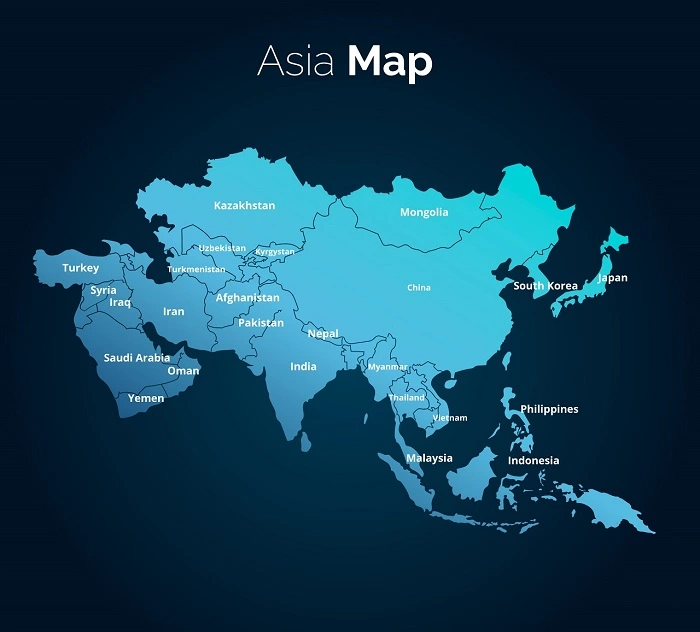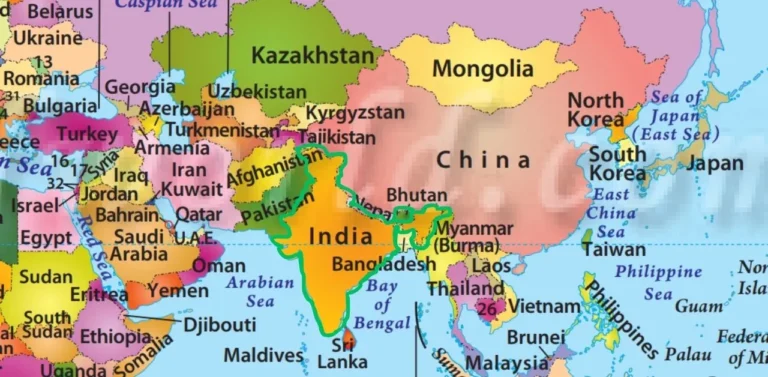India lies in Asia Continent, and it is located in South Asia Region with close neighbors China and Pakistan.
To the north, India shares its boundary with China, and the majestic Himalayan range acts as a natural divider between the two nations.
To the west, India is bordered by Pakistan, and to the east, it shares its borders with Bangladesh, Bhutan, and Myanmar. The southern boundary is flanked by the Indian Ocean, providing India with access to trade routes.
India, the land of diverse cultures, rich history, and unparalleled beauty, has been a subject of fascination for explorers, historians, and travelers alike.
This beautiful country, located in South Asia, is not only renowned for its vibrant traditions but also holds immense importance on the global stage.
India’s Geographical Location
India is a vast and diverse country that occupies a significant part of the Asian continent.
Geographically, it is situated in the southern part of Asia and lies largely on the Indian Plate, which is a major tectonic plate in the region.
To the north of India, lies the majestic Himalayan mountain range, which acts as a natural boundary between India and its neighboring countries like China and Nepal.
To the west, India is bordered by Pakistan, while the eastern and northeastern borders are shared with Bangladesh, Bhutan, and Myanmar. India’s southern boundary is flanked by the Indian Ocean, providing it with access to maritime trade routes.
India’s Precise Location in Asia
India’s precise location within the Asian continent is in the southern part of Asia. It is situated between latitudes 8°4′ and 37°6′ north and longitudes 68°7′ and 97°25′ east.
The country spans a vast land area of approximately 3.2 million square kilometers, making it the seventh-largest country in the world.
India’s Population and GDP
One of the most striking aspects of India is its huge population. As of 2023, India’s population had already surpassed 1.4 billion, making it the second most populous country in the world, after China.
This vast population diversity contributes to India’s richness in languages, traditions, and cultural heritage.
Despite facing various challenges related to population density, India has emerged as an economic powerhouse on the global stage.
The country has a mixed economy with a combination of traditional agriculture and modern industries. In recent decades, India’s economy has experienced substantial growth, and it has become one of the fastest-growing major economies in the world.
India’s Gross Domestic Product (GDP) plays a pivotal role in its economic significance. As of my last update, India had the third-largest GDP in terms of purchasing power parity (PPP), trailing only behind the United States and China.
The country’s diverse economic sectors, including services, manufacturing, and agriculture, contribute to its overall economic strength.
India’s Contribution to Asia’s Population
India’s population holds significant weight within the Asian continent. As mentioned earlier, India is the second most populous country globally, just behind China.
With a population exceeding 1.4 billion people, India accounts for approximately 17% of Asia’s total population.
The vast population of India not only shapes its domestic policies and social dynamics but also plays a crucial role in Asia’s overall demographic landscape.
The combination of India and China’s populations alone accounts for over one-third of the entire global population, making these two countries key drivers of demographic trends in Asia and the world.
India’s Contribution to Tourism
India’s allure goes beyond its sheer size and economic power. The country’s tourism sector is an essential aspect of its identity on the global stage. India’s rich history, cultural heritage, and breathtaking landscapes attract millions of tourists from all corners of the world.
The country boasts a myriad of UNESCO World Heritage Sites, such as the iconic Taj Mahal, the stunning temples of Khajuraho, and the historic Qutub Minar.
Each of these architectural marvels stands as a testament to India’s glorious past and enthralls visitors with its beauty and grandeur.
India’s diverse landscapes offer a unique travel experience for every traveler. From the pristine beaches of Goa to the snow-capped peaks of the Himalayas, and from the serene backwaters of Kerala to the bustling metropolises of Delhi and Mumbai.
India’s Significance in Asia
India’s importance extends beyond its geographical boundaries. As one of the major countries in South Asia, India plays a pivotal role in shaping the region’s political, economic, and cultural landscape.
India’s size and economic strength give it a strong voice in international forums and allow it to engage in strategic partnerships with other nations.
As a democratic nation, India’s commitment to democratic values and principles sets an example for other countries in the region and beyond. Its diplomatic approach focuses on maintaining friendly relations with its neighbors and contributing to regional stability.
Asia’s Place in the World

As for Asia, it is the largest and most populous continent on Earth. It covers about 30% of the world’s land area and is home to nearly 60% of the global population.
Asia is bordered by the Arctic Ocean to the north, the Pacific Ocean to the east, the Indian Ocean to the south, and Europe and Africa to the west.
It is a continent of immense diversity, with numerous languages, cultures, and traditions coexisting harmoniously.
India’s Influence on the Global Stage
India’s geopolitical importance extends beyond the Asian continent, and it holds considerable influence on the global stage.
As one of the world’s largest economies, India is an essential player in international trade and commerce.
The country actively engages in diplomatic relations with nations across the globe, participating in forums such as the United Nations, World Trade Organization, and various other multilateral organizations.
Furthermore, India’s emergence as a leading technology and innovation hub has garnered attention worldwide.
The country’s IT industry, in particular, has become synonymous with software services and technology solutions, contributing significantly to the global technology landscape.
Conclusion
India, with its immense population, strong economy, and cultural richness, holds a prominent place in the Asian continent.
Its geographical location, contributions to tourism, and significance in regional and global affairs make it an influential nation in the world.
As travelers continue to be drawn to India’s charm and its people’s warmth, the country’s significance on the world stage will undoubtedly continue to grow.
So, the next time you marvel at India’s wonders, remember that this incredible nation lies at the heart of the Asian continent, both geographically and metaphorically, contributing in more ways than one to the world we live in.




